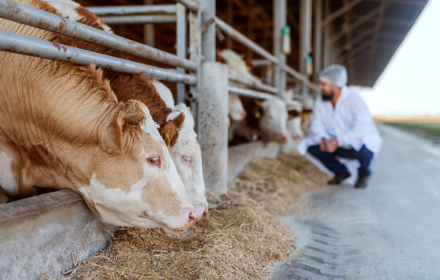AMR is the ability of microbes (such as bacteria, viruses, fungi) to counteract the effectiveness of antimicrobial drugs (such as antibiotics, antivirals, antifungals) against them. Even when antimicrobials are used appropriately, microbes can develop resistance. However, the development of resistance is accelerated by their misuse and overuse in human, animal, and plant health along with the pollution of the environment with antimicrobials and antimicrobial resistance genes.
Drug-resistant infections already claim at least 700,000 lives a year, including 230,000 deaths from drug-resistant tuberculosis (WHO, 2019). By 2050 resistant infections could kill 10 million people annually and lead to an economic slowdown comparable to the global financial crisis of 2008. As life-saving antibiotics stop being effective, AMR could end our capacity to combat infections.
Antibiotics in Animal Husbandry
Antibiotic usage in animals is an imperative factor contributing to the wider spread of resistance, particularly with intensive animal production. The spread of resistant bacterial populations can be transmitted from animals to humans via direct contact between the two or through the food chain and the environment. WHO recommends an overall reduction in antibiotics usage within food-producing animals to help preserve their effectiveness for human medicine (WHO, 2017).
Antimicrobials are critical for animal health, welfare, and food security when used to treat infections in agriculture and aquaculture. However, infection treatment is not always the leading reason for antimicrobial use; globally, antimicrobials are used most often to prevent infections, compensate for poor husbandry practices, and/or to promote growth (AMR Review, 2016; Landers et al., 2012). Although data on the exact amounts of antimicrobials used in global food production is deficient or completely absent in certain areas, the data we do have paints a serious picture. In the US for example, more than 70% of antibiotics considered to be medically critical for human health are used in livestock (AMR Review, 2015). Research predicts that this high level of antibiotics in agriculture will only increase without intervention; globally, consumption is expected to increase by 67% from 2010 to 2030 while consumption in BRICS countries (Brazil, Russia, India, China, and South Africa) specifically, is predicted to rise by 99% over the same 20 years (Van Boeckel et al., 2015).
When an infection has not responded to other drugs, last resort antibiotics may come into play; the frequent use of these last resort drugs in livestock can rapidly increase the threat of AMR and impact our ability to continue to use them effectively in human medicine when they are routinely absorbed in low levels through the food chain. Colistin is used very sparingly in humans as it can cause kidney failure; however, when no other antibiotics have been effective, colistin is an important last resort (AMR Review, 2016). Widespread use of colistin in animals has led to resistance in animal pathogens, which has concerning implications for human health. A recent study in China has shown the discovery of transferable colistin resistance in bacteria in both humans and animals (Yi-Yun Liu et al., 2016).
AMR Globally
Various types of resistant bacteria have been reported in Thailand, Venezuela, India, the United States, and China; one type of resistant bacteria in India was even been found in the High Arctic (CNN, 2019). Europe is not immune to the dangers of AMR either; in the Netherlands, where antibiotic use in husbandry has even been reduced by 64% (All About Feed, 2017), a patient died due to a urinary tract infection caused by drug resistant bacteria. This was the first outbreak of this bacterium carrying the ndm gene in the Netherlands, infecting 38 patients over a period of 16 months (NOS, 2019). Globally the threat of AMR is on the rise; In the first study to cover the entire supply chain of broiler meat in Indonesia, researchers found the mcr-1 gene in 89.66% of colistin-resistant E. coli. More research into this topic should be encouraged as AMR was responsible for 130,000 deaths in 2015 in Indonesia alone as per sources of the Health Ministry (The Jakarta Post, 2015).
Animal husbandry presents a multitude of problematic antibiotic use practices ranging from growth promotion to both metaphylactic and prophylactic use. Metaphylactic use attempts to prevent infections spreading from sick animals to healthy ones. However, in practice this only aids in the development of antibiotic resistance by adding large, unnecessary quantities of antibiotics to animals and the environment. (AMR Review, 2015). Despite using antibiotics to attempt to reduce disease spread, it is often difficult to avoid due to cramped conditions which expounds the problem. Growth promotion is seen as the most egregious non-therapeutic use of antibiotics; consequently, the practice was banned in the EU in 2006 (REGULATION (EC) No 1831/2003). However, it is still allowed in the US and other countries around the world.
In the EU, as per the new rules adopted by the European Parliament and the Council in 2018 (Regulation (EU) 2019/6), antimicrobials must be limited to a single animal and justified by a veterinarian. An exception exists only when there is a high infection risk; in this case, collective treatment is permitted if no suitable alternatives exist.
 Are the antimicrobials used in animals identical to those used in treating infections for humans?
Are the antimicrobials used in animals identical to those used in treating infections for humans?

 Report
Report

